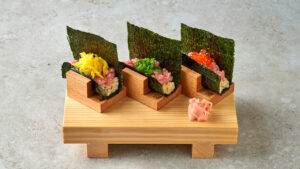From clothing to ramen to sushi

The Farillas couple explains the similarities in their different business ventures as they open their latest, Nagi Sushi
TWO different culinary disciplines of Japan are melded by the Ramen Nagi group, with the opening of its first sushi restaurant in the Philippines (and the first outside Japan), Nagi Sushi.
While Ramen Nagi (celebrating its 10th year in the Philippines) concentrates on the rich Japanese noodle soup, Nagi Sushi will be focused on the more delicate sushi. However, in Nagi Sushi, one can also have the ramen options in case the craving for something more substantial comes.
During a tasting on Oct. 6 at its first branch in The Shops at Ayala Triangle, Makati, we did exactly that, taking the Original King ramen (with a rich pork broth), which unfortunately came before our delicate sushi rolls. But we still got to taste our sushi — just delicate slices of tuna and salmon, or with rice, or in the case of one roll, wrapped up in a cone with rice and other toppings. Besides, the best was yet to come.
During the opening, Nagi Group’s sushi chef butchered a very fresh fish in front of the gathered guests for a sushi masterclass. A knife tore through skin and flesh like paper, while bones snapped like twigs. According to the chef, one needs a special knife, one with thick edges, to do this. He said that one can learn how to cut a fish in one day, but to become an expert, one has to practice every day (he has been working with fish for 30 years). “You have to apply what you have learned,” he said through an interpreter.
Tackling the 50-kilogram tuna must have been hard, and we felt his assistant’s difficulty in cutting through the tough tail. The chef said that a good fish must be fat, with lots of fat lining the belly, and its blood should be red.
The belly and other parts were quite easy to cut however, and even then, the prized belly was ignored for something more special: the nakaochi. These are bits of flesh that cling to the spine, which are scraped and collected on a plate, and brushed lightly with soy sauce. This was extra-tender, with a very firm, very dense texture that announced itself as fish flesh. The deep ruby-red slivers literally melted in the mouth with the slightest tap of the tongue towards the palate.
PLAINS, PRINTS, AND SUSHILike Ramen Nagi, Nagi Sushi was also brought here by the Farillas couple who are behind the clothing company Plains and Prints. “We want to bring it here to show Filipinos that ramen and sushi really go well together,” said Roxanne Farillas, co-founder of Plains and Prints.
They first brought Ramen Nagi to the Philippines in 2013, and now have 37 branches. It’s this growth that led to the Japanese principals entrusting them with Nagi Sushi’s first store outside Japan. “We have the most branches outside of Japan,” said Ms. Farillas. Of this large number of branches, she noted that “It’s very important to be in different sites. Metro Manila has many different cities. For the prime malls, we have to position ourselves there so it’s easy access for all.”
She reminisced about the journey of bringing Ramen Nagi here with her husband, Erickson. “We travel a lot for work and leisure. We came across this hole-in-the-wall ramen place in Hong Kong. There was a long line,” she said, which attracted them. “Niligawan namin iyong (we courted) principals for quite a long time,” she remembers.
It paid off, and no’ the principals come once a month to check if their ventures’ offers are close to the taste of the original Japanese outlets. Ms. Farillas points out that all their ingredients are imported from Japan. In the case of Nagi Sushi, the Japanese chefs will stay for a few months to train everyone. “That is something we’re very proud of,” she said. Expansion plans for Ramen Nagi might include ventures outside Luzon.
What are the differences between running a clothing company and a restaurant chain? The similarities? A huge difference is in manpower, with restaurants having to have staff in the front and back of the house. “Unlike in the retail stores, [where] it’s really just about sales associates,” she said. “[Then] there’s wastage,” she noted about the food biz, unlike in clothes where they can be stocked indefinitely. Still, some values work wherever they’re used, and Ms. Farillas said, “We’re very hands-on. My husband is very hands-on with Ramen Nagi. He still is involved with Plains and Prints, but now, he’s more focused on the restaurant business.”
“Detailed with everything,” was a trait she noted about her husband. “I guess that’s the same treatment that we did with apparel and food.” — Joseph L. Garcia




